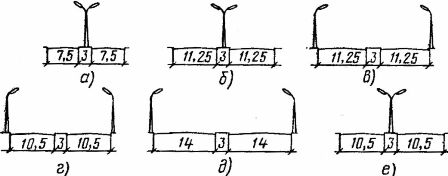Outdoor urban lighting
The unity of the bright appearance of the city
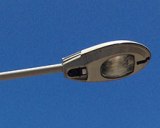 Lighting installations in cities, urban-type settlements and rural areas should not only meet the requirements for traffic and people's safety, but also be part of the harmonious composition of the city's evening appearance.
Lighting installations in cities, urban-type settlements and rural areas should not only meet the requirements for traffic and people's safety, but also be part of the harmonious composition of the city's evening appearance.
In the artificial lighting of the city, separate elements are distinguished that act together, mostly simultaneously, actively influence each other and depend on each other, which are: lighting of the city's roadways, light indicators, signaling, lighting of architectural structures ( small forms of architecture, monuments, green spaces, etc.), informational and advertising lighting (lighting of shop windows, restaurants and various institutions for culture and recreation).
Holiday lighting also interacts with other lighting elements in the city. Illumination of streets and adjacent sidewalks is not only carried out by street lighting fixtures: a significant part of the light flux falls on them and by architectural lighting fixtures for building facades, illuminated shop windows and illuminated advertisements.
On the facade of a building, with special lighting, light falls from lighting fixtures on the street, from advertising lights, shop windows of the building opposite the illuminated one, etc.
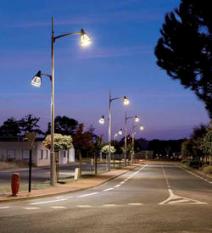 In the lighting installations of cities, it is necessary to determine the recommended types of light sources and lamps, to distribute them on the squares and streets of the city, to set the height of their location relative to the canvas of the street or square, to choose the height and structure of the supports . It is necessary to identify the degree of influence of the illuminated shop window on the illumination of the sidewalk and the street lane, as well as the facade of the building on the other side of the street.
In the lighting installations of cities, it is necessary to determine the recommended types of light sources and lamps, to distribute them on the squares and streets of the city, to set the height of their location relative to the canvas of the street or square, to choose the height and structure of the supports . It is necessary to identify the degree of influence of the illuminated shop window on the illumination of the sidewalk and the street lane, as well as the facade of the building on the other side of the street.
In combination with street lighting, lighting is being developed on the facades of buildings with historical or cultural significance. After that, glowing advertisements and information are developed. The advertising solution should be considered in relation to the overall lighting solution of the city. Advertising and light information are one of the means of expressiveness in solving the general problem of creating light architecture.
When lighting gardens, boulevards and squares, it should be taken into account that in the area of green areas there are usually no additional light flows due to architectural, advertising and display lighting.
In an architectural-artistic aspect, a complex complex of artificial lighting is a harmoniously connected work of art, in which the architectural solution of street lighting depends not so much on the levels of illumination, but on the harmonious combination and stylistic unity of the individual parts of the lighting installation and the degree of reduction of glare in the field of view.
Lighting of streets, roads and squares
The design of outdoor lighting in cities should be carried out in accordance with CH541-82 (Guidelines for the Design of Outdoor Lighting in Cities, Urban-Type Settlements and Rural Settlements).
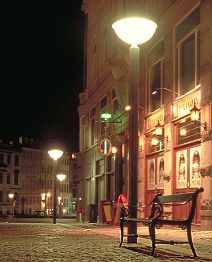 In outdoor lighting installations in cities with an average coverage of 0.4 cd / m2 and more and an average illumination of 4 lux and more, gas discharge light sources should be used — mainly DRL, MGL, NLVD lamps. In Moscow and other cities, DKstT xenon lamps are used to illuminate squares. Incandescent lamps are used only in villages or on city streets of local importance. Fluorescent lamps are rarely used, mainly in southern resort towns, because their operation in the middle and northern climate zones is difficult.
In outdoor lighting installations in cities with an average coverage of 0.4 cd / m2 and more and an average illumination of 4 lux and more, gas discharge light sources should be used — mainly DRL, MGL, NLVD lamps. In Moscow and other cities, DKstT xenon lamps are used to illuminate squares. Incandescent lamps are used only in villages or on city streets of local importance. Fluorescent lamps are rarely used, mainly in southern resort towns, because their operation in the middle and northern climate zones is difficult.
The transport and pedestrian tunnels are lit with gas discharge light sources, the pedestrian tunnels are mainly lit with fluorescent lamps of the LB type. It is recommended that transport tunnels be lit with enclosed luminaires with a jet-resistant design. To illuminate streets and roads with a standardized brightness of 0.4 cd / m2 and a higher or average illuminance of 4 lux, lamps with a wide or semi-wide light distribution are used.
The lighting of alleys, footpaths and footpaths is usually carried out with corona lamps with diffused or mainly direct light. Lighting fixtures of the SVR type with DRL lamps with a power of 125 and 250 W are widespread. Narrow alleys, sidewalks and platforms located near buildings are illuminated by lamps mounted on the walls of buildings, provided that they are easily accessible, for example, of the RBU type with a 125 W DRL lamp.
The lighting fixtures for street lighting are installed on special posts made of steel, aluminum, reinforced concrete and wood. In domestic practice, reinforced concrete supports are mainly used. Wooden supports are used only in villages, on small streets. The set of supports, brackets and lamps is a street lamp (Fig. 1, a-d).
Distinguish between coronal and cantilever lanterns, differing in the way the lighting fixtures are fixed. It is recommended to illuminate narrow streets (up to 20 m wide) with perimeter buildings with devices suspended on cables, as well as attached to buildings on brackets.
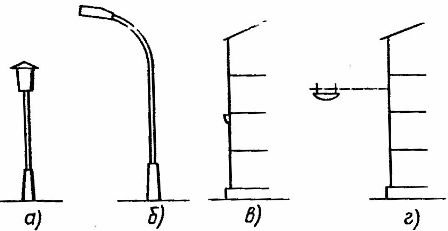
Rice. 1. Schemes for installing street lamps: a — coronation, b — console, c — wall, d — suspended.
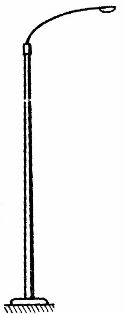
Rice. 2. Street lamp with reinforced concrete support and steel console.
With the free development of residential areas, lighting is mounted on poles.
Lanterns are often found, the support of which bends at an angle of 15 °, and this curved part serves as a bracket for fixing the light fixture. Most modern cantilever lighting fixtures are designed to be installed at this angle. Some of them have a curved tube. Such lighting fixtures must be mounted on horizontal brackets. It is not allowed to install the lighting unit at an angle of 30-40 °. A typical street lamp with a reinforced concrete support and a steel tubular bracket is shown in Fig. 2.
When installing lighting fixtures on wire ropes, their vibration often occurs, which is transmitted to the buildings to which they are attached. To avoid this, the cables must be secured with special shock absorbers. The types of poles for outdoor lighting must be applied in accordance with the technical rules for the economical use of basic building materials.Consider the basic requirements for the location of supports in CH541-82.
The distance from the front edge of the side stone to the outer surface of the support base must be at least 0.6 m. This distance in residential areas can be reduced to 0.3 m in the absence of bus and trolleybus traffic, as well as the movement of heavy duty trucks. The supports at the intersection of streets and roads are recommended to be installed before the curve of the sidewalks and no closer than 1.5 m from different entrances without disturbing the uniform system of the line for installing the supports.
The distance between the support and underground utilities is taken in accordance with the requirements of SNiP for planning and development of cities, towns and rural settlements, for external networks and structures, for electrical devices. Supports for lighting fixtures on external engineering structures (bridges, overpasses, overpasses, dams, etc.) must be installed in alignment with fences, steel beds or on flanges attached to the supporting elements of the engineering structure.
For bridges and dams, in order to provide the necessary level of illumination, a large number of lanterns are installed, which often do not match the architecture of the bridge in terms of design and scale. The reduction in their number leads to the use of technically irrational multi-lamp lanterns, which do not provide sufficient uniformity of illumination. Therefore, they began to use lighting devices built into the fence of bridges and other engineering structures.
On streets with tram or trolleybus traffic, the lighting fixtures are placed on catenary supports, on which lighting fixtures with public overhead electrical network must be suspended.
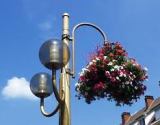 Park alleys and footpaths do not require intense lighting, as there is no traffic on them. You can often limit yourself to lighting only the main alleys and paths. It should be borne in mind that the boulevard usually receives light from neighboring streets. For gardens and boulevards, it is advisable to use floor lamps with crowning lamps, while the supports should be located outside the pedestrian part of the paths (on lawns together with trees, benches, etc.).
Park alleys and footpaths do not require intense lighting, as there is no traffic on them. You can often limit yourself to lighting only the main alleys and paths. It should be borne in mind that the boulevard usually receives light from neighboring streets. For gardens and boulevards, it is advisable to use floor lamps with crowning lamps, while the supports should be located outside the pedestrian part of the paths (on lawns together with trees, benches, etc.).
Above the canvas for traffic on streets, roads and squares, the lamps must be installed at a height of at least 6.5 m. The suspension height of the lamps, when located above the tram catenary, must be 8 m from the rail head and when it is located above the contact network of the trolleybus — at 9 m from the parts at the level of the roadway.
In lighting installations for lighting bridges and overpasses, when using lamps with a protective angle of at least 10 ° and excluding the possibility of accessing lamps without a special tool, the height of their installation is not limited, in transport tunnels with the same protective angle, the height of installing the lamp must be at least 4 m.
In pedestrian tunnels, it is recommended to use lighting fixtures with a protective angle of 15 ° or more for fluorescent lamps with a total power of 80 W and DRL lamps with a power of 125 W; the use of lighting fixtures with matte and milky diffusers without reflectors for DRL lamps with a power of 125 W is allowed.
CH541-82 provides several optimal layouts for placing lamps on the street (Fig. 3).Depending on the width and category of the streets, different lighting schemes are used: one-sided, two-row located, two-row rectangular, axial, two-row rectangular along the axes of movement, two-row rectangular along the axis of the street.
Schemes 1-3 and 6 correspond to the cases of installation of lanterns, and 4 and 5 to the suspension of lighting fixtures on cables. On the bends of streets and roads with a radius of curves in the plan along the axis of the traffic lane 60-125 m, lamps with a one-sided arrangement should be placed on the outside of the street according to fig. 4, a.
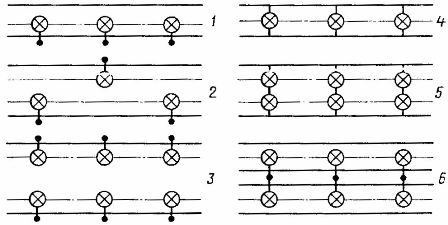
Rice. 3. Placement of lanterns in street and road lighting installations. 1-one-sided, 2-two-row located, 3-two-row rectangular, 4-axial, 5-two-row rectangular along the axes of movement, 6-two-row rectangular along the axis of the street
The lighting of railway crossings and pedestrian crossings at one level should be provided with lamps located in the schemes corresponding to fig. 4, b, c.
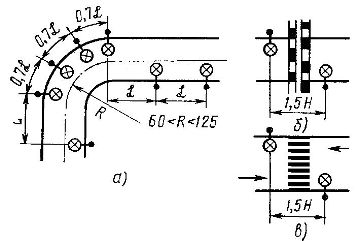
Rice. 4. The location of lamps: a — at a rounding, b — at a railway crossing, c — at a pedestrian crossing, L — pitch of lamps, H — height of installation of lamps, R — radius of curvature in plan along the axis of the road
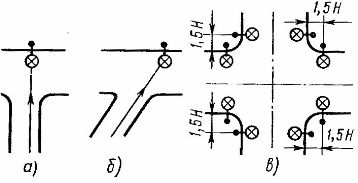
Rice. 5. Placement of lighting fixtures at intersections: a, b — at intersections, c — at intersection, H — installation height of lighting fixtures
It is recommended that intersections be illuminated at one level in accordance with the diagrams shown in fig. 5. For illumination of large areas, when it is desirable to reduce the number of supports or completely abandon them, lighting fixtures with DKst lamps of high unit power (20 kW) mounted on 25 m high masts are used.
Spotlights placed on the roofs of buildings are also used for the same purpose (illumination of areas). The main disadvantage of floodlights is the blinding effect they have on pedestrians, drivers, and also interfere with the perception of the architecture of the square in the evening.
Typical solutions for street and road lighting
On the basis of CH541-82, "Typical solutions for street and road lighting" were developed, which made it possible, without time-consuming calculations, to determine the main parameters of lighting installations on streets and roads in cities, depending on the brightness of the road surface, the distribution of brightness and glare index, and to evaluate and compare different lighting installations in the preparation of feasibility studies for architectural planning and engineering solutions for development.
Typical solutions contain layouts, the type of lamps and light sources, the recommended height of their installation, the step and number of lamps (supports) per 1 km of the road, the installed power of the lighting installation per 1 km of the road, per 1 m2 of illuminated lanes, as well as the installed power, reduced to 1 cd / m2 normalized average brightness or 1 lx / m2 normalized average illuminance, depending on the width of the roadway.
The installed power of the lighting installation, referred to 1 m2 of the roadway and the unit for the degree of illumination, allows you to choose the most efficient lighting fixtures in terms of energy consumption to create an average brightness or degree of illumination.
Rice. 6. The location of the lamps: a, b, f — two-row rectangular along the axis of the street, c, d, e — two-row rectangular
The final choice of the lighting option should be made according to a technical and economic evaluation, taking into account the cost indicators according to the approved (current) price tags.
Typical solutions are compiled for the most common lighting system, where the lighting fixtures are mounted on poles or suspended on a cable at a height of 6.5-15 m in accordance with the layouts shown in fig. 3.
The selection of the parameters of lighting installations depending on the width of the roadway, taking into account the category and layout of the streets, architectural requirements, etc., is carried out according to the tables given in "Typical solutions for street and road lighting", based on of technical and economic assessment.
Options for lighting installations on streets and roads are designed for the width of the road surface that meets the requirements of SNiP II-60-75 "Planning and Development of Cities, Towns and Rural Settlements" for the profiles of streets and roads shown in Fig. 6 using lamps produced by local industry.
In addition, "Typical Solutions" contains examples of street lighting with different profiles. In the calculations of lighting installations, the values of light fluxes provided by the current GOST for light sources are taken. The installation height and the distance between the lighting fixtures are calculated for each norm, taking into account the uniformity of the distribution of brightness (Lmax / Lmin) or illuminance (Emax / Emin) and the limitation of glare.The installed power of lighting installations with gas discharge light sources is calculated taking into account losses in the control device (ballast).
In addition to "Typical solutions for street and road lighting" "Guidelines for the design of outdoor lighting installations in the Far North" have been developed. These recommendations provide typical solutions for street and road lighting installations, taking into account prolonged adverse weather conditions (fogs, snow storms).

Rice. 7. The cross profile of the main street for use throughout the city.
"Instructions for the operation of outdoor lighting installations in cities, urban-type settlements and rural settlements" contain requirements for maintaining the technical condition of outdoor lighting installations, in which their quantitative and qualitative indicators correspond to the specified standardized parameters.
The document includes requirements for centralized switching on and off of outdoor lighting, rational use of electricity and funds allocated for the maintenance of installations, ensuring the safety of operating personnel and the population, maximum mechanization of service installations for outdoor lighting and increasing labor productivity during operation and repair personnel.

